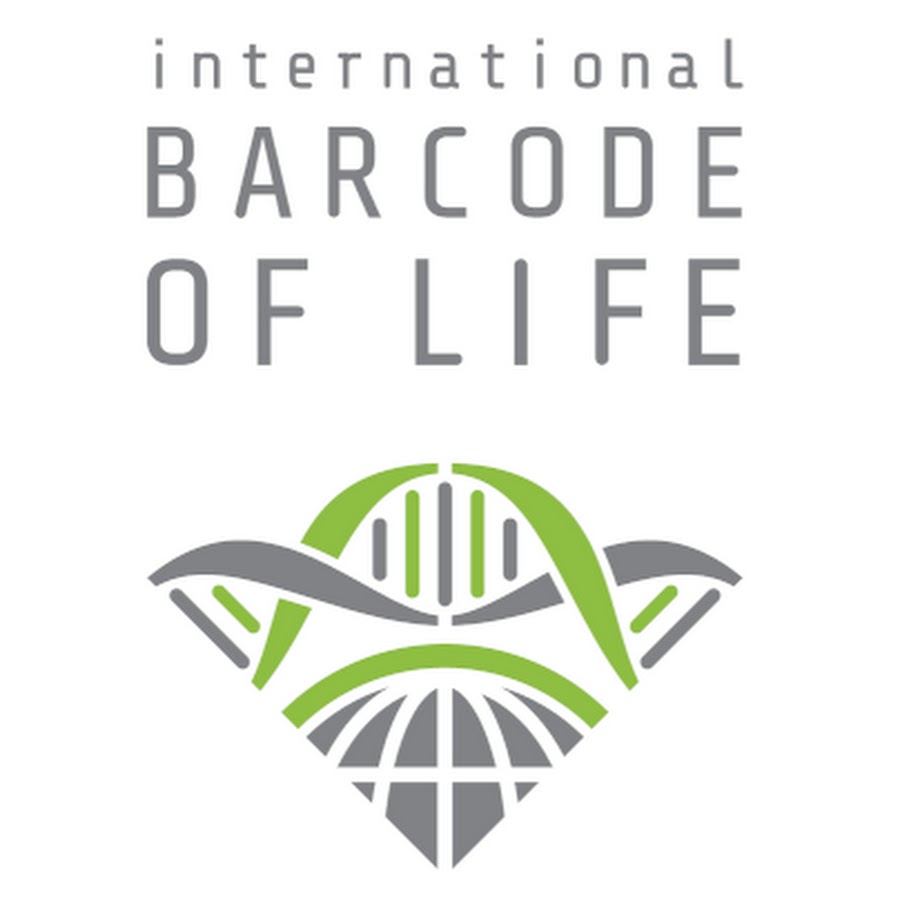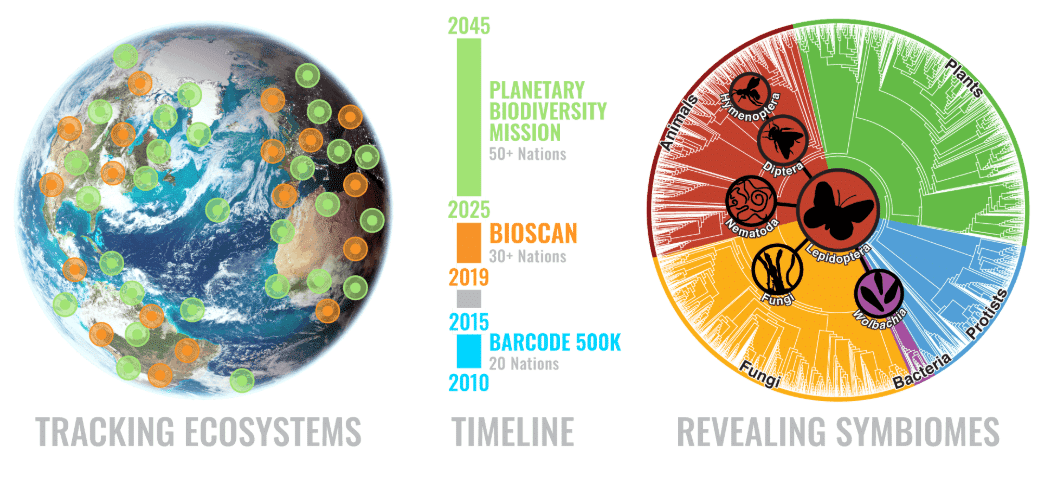
The Barcode of Life is a project to create a public collection of reference sequences from vouchered specimens of all species of life. A Barcode sequence is a short nucleotide sequence from a standard genetic locus for use in species identification. For animals, this standard genetic locus is a 650 base pair region on the 5′ end of the mitochondrial cytochrome oxidase subunit I (COI) gene.
— NIH
Big funding boost for iBOL
New grants raise total investment to $80m
The International Barcode of Life Secretariat has announced major new funding for the world’s largest biodiversity genomics project. iBOL Scientific Director Paul Hebert said that four Canadian agencies have made new commitments to iBOL totaling $35 million, raising total investments by these funders to $80 million (all figures in Canadian dollars).
Building on an earlier $5 million award, the Ontario Ministry of Research and Innovation has committed another $8.1 million over the next five years to expand the informatics platform for DNA barcode data.
And Genome Canada is extending its support for the iBOL project for another year with a second funding installment of $4.6 million. This follows the $2 million provided by Genome Canada in 2009-10 to initiate the project through its International Consortium Initiative Program.
Dr. Christian Burks, President and CEO of the Ontario Genomics Institute and acting chair of the iBOL Board of Directors, said: “The many international partnerships that comprise iBOL, and which are absolutely key to its success, will benefit tremendously from these funding commitments. We anticipate that the funded research and resources at the Canadian node for iBOL will be greatly leveraged by iBOL nodes in other countries that have already committed funds and research efforts to the project, and will help other potential international partners finalize their commitments to participate in iBOL.”
Dr. Hebert said: “As the iBOL project approaches the end of its one-year preparatory phase, we look forward to official activation of this global undertaking with renewed optimism and determination. We are grateful for the vision shown by our federal and provincial governments and by their science funding agencies. Their leadership is enabling an initiative that will transform humanity’s relationship with other living organisms.”
Dr. Hebert announced that groundbreaking for the new Centre for Biodiversity Genomics will take place this summer at the University of Guelph. This $18 million facility, funded by the Canada Foundation for Innovation and the Ontario Ministry of Research and Innovation will house the iBOL Secretariat and key infrastructure needed to support iBOL research. The new centre, which will be the scientific hub for iBOL, is scheduled for completion in fall 2011. (see story on page xx)
Dr. Hebert also welcomed significant contributions from the Natural Sciences and Engineering Research Council of Canada, which awarded $1.2 million to support new DNA barcoding research programs, and from Canada’s International Development Research Centre (IDRC), which has provided $2.2 million to enable researchers in five developing countries – Argentina, Costa Rica, Kenya, Peru and South Africa – to play key roles in iBOL.
Dr. Faustino Siñeriz, Vice-President of Argentina’s National Council of Scientific and Technical Research, welcomed the additional support provided by IDRC, noting that it reinforced his organization’s recent decision to upgrade Argentina’s participation in iBOL to a Regional Node.
Paul Skelton, Director of the South African Institute for Aquatic Biodiversity, said that the IDRC funding would make African biodiversity a much more significant part of the iBOL research program. “It will provide a major incentive for South African institutions to meet the requirements of Regional Node participation in iBOL while giving organizations and researchers from a wide range of African nations the opportunity to contribute to and benefit from IBOL,” Dr. Skelton said.
— International Barcode of Life press release, April 23, 2010
Official launch of iBOL activates world’s largest biodiversity genomics initiative
Toronto – The largest biodiversity genomics initiative ever undertaken – an international effort to build a digital identification system for all life on Earth – will be officially activated this week.
The International Barcode of Life Project (iBOL) will be launched by the Minister of Research and Innovation, Glen Murray, during an event at Toronto’s CN Tower on Saturday, September 25 at 6:30 p.m.
By enabling automated, rapid and inexpensive species identifications, iBOL will transform biodiversity science and its applications throughout society. “We are witnessing alarming rates of species extinction,” said iBOL Scientific Director Paul Hebert, “but efforts to reverse that trend are hampered by huge gaps in our knowledge about the distribution and diversity of life. DNA barcoding promises a future where everyone will have rapid access to the names and biological attributes of every species on Earth.”
Dr. Hebert said that DNA barcodes will be a vital tool not only for conservation but also for monitoring species that have adverse impacts on human health and economic wellbeing. “We are only beginning to scratch the surface of how DNA barcoding will impact the way we live, work and play,” he said.
DNA barcoding is a method for identifying species using a short DNA sequence from a standard location on the genome. The technique dramatically reduces the time and cost of species identification. Moreover, because DNA barcode libraries are in digital format, fully automated identification is now possible for a growing number of species.
Work over the past five years has produced one million barcode records representing almost 80,000 species and provided the impetus for the launch of iBOL, the large-scale genomics project that will not only massively expand the DNA barcode reference library but also develop the technologies to read it, including a table-top barcoder.
iBOL has been established as a not-for-profit corporation overseen by an international board of directors representing funding organizations. More than 25 countries are involved and major commitments have been made toward the Phase 1 (2010-2015) operating budget of $150 million. The Biodiversity Institute of Ontario at the University of Guelph will soon treble in size to both accommodate the iBOL secretariat and greatly expanded facilities for barcode analysis and data storage.
By the end of the first phase in 2015, consortium members will have entered DNA barcode records from five million specimens representing half a million species into the interactive Barcode of Life Data System (BOLD) databank, creating the launchpad for a subsequent push towards a DNA barcode reference library for all of Earth’s animal, plant and fungal species.
“The International Barcode of Life is assembling a global network of taxonomists, biologists and geneticists to embark on the next great exploration of the natural world,” said Dr. Christian Burks, President and CEO of the Ontario Genomics Institute and Chair of the iBOL Consortium board of directors. “It will bring about fundamental changes in the way we view Earth’s biodiversity and our relationship to it.”
— International Barcode of Life press release, September 2010

Six main steps of DNA barcoding and metabarcoding
Zoologica Scripta
Sources:
- April 23, 2010. “Big Funding Boost for iBOL.” International Barcode of Life.

https://web.archive.org/web/20110104163531/http://ibol.org/big-funding-boost-for-ibol/,
http://ibol.org/wp-content/uploads/2010/05/iBOL-Media-Release-23April-FINAL.pdf.
General Website Link. - September 2010. “Official Launch of iBOL Activates World’s Largest Biodiversity Genomics Initiative.” International Barcode of Life.

https://web.archive.org/web/20110104151147/http://ibol.org/official-launch/,
https://web.archive.org/web/20110104165402/http://ibol.org/wp-content/uploads/2010/09/Media-Release-Launch-of-iBOLFINAL.pdf.
General Website Link. - May 2015. Sarah J. Adamowicz. “International Barcode of Life: Evolution of a Global Research Community.” Genome 58 (5): 151–62.

https://doi.org/10.1139/gen-2015-0094.
Research Journal. - August 24, 2021. Rhoda Wilson. “The Barcode of Life – Do We Really Understand What It Is and What It Aims To Do?” The Exposé.

https://expose-news.com/2021/08/24/the-barcode-of-life-do-we-really-understand-what-it-is-and-what-it-aims-to-do/.
News. - “The International Barcode of Life Consortium.” International Barcode of Life.

https://ibol.org/.
General Website Link. - “Barcode of Life Data System V4.” Bold Systems.

https://boldsystems.org/.
General Website Link. - “BarCode of Life.” National Center for Biotechnology Information.

https://www.ncbi.nlm.nih.gov/genbank/barcode/.
National Institutes of Health.
Note the links on the right side under “Barcode Resources.”
Related:
- August 10, 2016. Nurrahmi Dewi Fajarningsih. “Internal Transcribed Spacer (ITS) as Dna Barcoding to Identify Fungal Species: A Review.” Squalen Bulletin of Marine and Fisheries Postharvest and Biotechnology 11 (2): 37.

https://doi.org/10.15578/squalen.v11i2.213.
Research Journal. - September 27, 2016. Anne-Jifke Haarsma, Henk Siepel, and Barbara Gravendeel. “Added Value of Metabarcoding Combined with Microscopy for Evolutionary Studies of Mammals.” Zoologica Scripta 45 (S1): 37–49.

https://doi.org/10.1111/zsc.12214.
Research Journal. - May 29, 2019. GenomeScan. “Some Highlights from SMRT Meeting, Leiden, May 2019.” GenomeScan.

https://www.genomescan.nl/2019/05/29/smrt-meeting-highlights/.
General Website Link.
See also, on this site:

